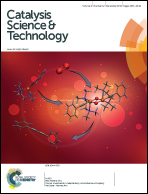The effect of the oxidation environment on the activity and selectivity to aromatics and octenes over cobalt molybdate in the oxidative dehydrogenation of n-octane†
Abstract
A cobalt molybdate catalyst was synthesised by the co-precipitation method and characterized by XRD, BET-surface area measurements, ICP-OES, Raman, TPR, TPO, SEM and SEM-EDX. XRD results showed that the dominant phase in the catalyst is the β-phase. The ratio of Co : Mo was determined by ICP-OES to be 1 : 1.04. The excess molybdenum is found in the molybdenum trioxide phase as shown by the Raman results. The TPR/O/R/O/R results showed that the catalyst can undergo the redox cycle where cobalt molybdate reduces to the molybdite and spinel form of cobalt molybdate (by 5% hydrogen) and oxidize back to the cobalt molybdate after oxygen exposure. The catalytic testing was carried out in a continuous flow fixed bed reactor at atmospheric pressure and a temperature range of 350 to 550 °C in 50 °C intervals with different oxygen content (i.e. C : O ratio of 8 : 0, 8 : 1, 8 : 2, 8 : 3 and 8 : 4) in the reaction mixture. The conversion of n-octane increased with increase in the oxygen content in the reaction mixture, which was accompanied by changes in the selectivity patterns. The dominant products were the octenes and COx at all temperatures and different carbon to oxygen ratios. Furthermore, the selectivity to aromatic products increased with increase in the strength of the oxidising environment in the feed mixture and was dominated by styrene and ethylbenzene (both products of 1,6-cyclization). The yields of octenes, aromatics, cracked products and COx at 500 °C showed that an increase in the oxygen content resulted in a decrease in the yield to octenes and an increase in what can be considered secondary products (i.e. aromatics and COx). The total selectivity percentage of value-added products (i.e. octenes and aromatics) also decreased with increase in the oxygen content, due to the increase in cracked products and COx yields (which are not considered value added products). Characterization of the spent catalysts at the different conditions showed that the catalyst maintains the cobalt molybdate phase under the 8 : 2, 8 : 3 and 8 : 4 C : O conditions, while complete segregation took place under dehydrogenation conditions and partial segregation occurred at an 8 : 1 C : O ratio.


 Please wait while we load your content...
Please wait while we load your content...